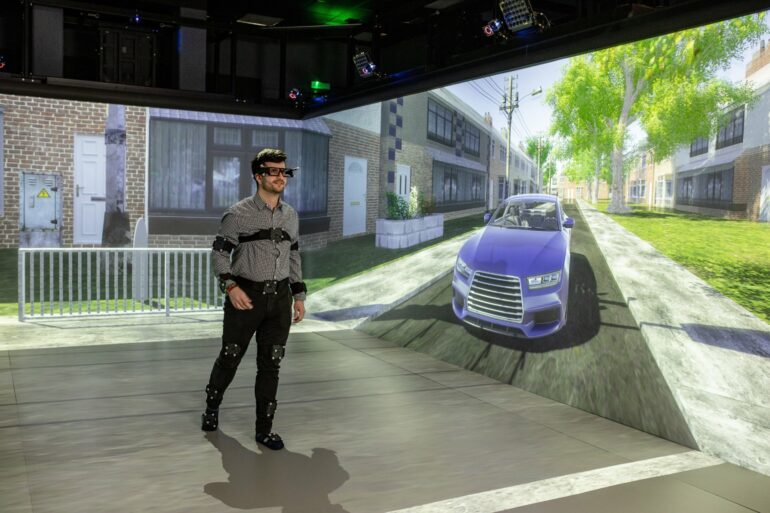Algorithms that accurately reflect the behavior of road users—vital for the safe roll out of driverless vehicles—are still not available, warn scientists.
They say there is “formidable complexity” in developing software that can predict the way people behave and interact on the roads, be they pedestrians, motorists or bike riders.
To improve the modeling, a research team led by Professor Gustav Markkula from the Institute of Transport Studies at the University of Leeds has developed the first-ever simulation of how people behave on the roads based on key cognitive theories.
Those separate theories were integrated into a larger, single psychological model that would “describe behavior in more complex, real-world tasks.”
During computer tests, the model accurately reproduced various well-known but not previously understood behaviors of pedestrians and drivers in common road scenarios. The model also predicted how real-life human subjects would behave when facing interactive situations in a virtual reality simulator.
Professor Markkula said, “These findings suggest that everyday road user behavior relies on a number of complex underlying cognitive mechanisms, which may be part of the reason why it has been more difficult than expected to create self-driving vehicles.”
“Our research shows that it is possible to integrate separate theories from psychology into combined theories for applications such as simulating the way people behave in traffic, which is something which has been called for but rarely achieved.”
The researchers’ findings—Explaining human interactions on the road by large-scale integration of computational psychological theory—are published in PNAS Nexus.
Algorithms needed to unlock self-driving revolution
The development of automated vehicles could have a major impact on the UK economy.
In a vision statement, the UK Government has said driverless vehicles will launch a £42 billion industry and create 38,000 new jobs. The aim is to see the start of the safe roll out of driverless vehicles by 2025.
But writing in the journal PNAS Nexus, the researchers argue that work towards driverless vehicles has been “hampered by a lack of models of how human road users interact.”
Accurate models are needed to run simulations necessary in both development and testing of driverless vehicles and their control systems, for example to demonstrate that the vehicles remain safe when confronted with a range of human behavior on the road.
Up to now, most computer models of road user behavior have been statistically based, with predictions of how people might behave based on analysis of large datasets, but typically without analyzing those models at a detailed behavioral level.
The research by Professor Markkula and his team has instead focused specifically on the details of human behavior and key concepts in human psychology.
Road user behaviors and theories
The researchers looked at several typical human behaviors that exist on the road, such as hesitation in unclear situations, or implicit communication using vehicle or body movement to assert priority or to encourage someone else to go first.
The model predicts how people will behave by reference to key cognitive theories. For example, one is “theory of mind,” where people will form beliefs about what someone else is doing and how their own behavior may affect decisions being made by the other. This relates also to “behavioral game theory,” explaining how people consider the combined effects of their own behavior and the behavior of others when deciding what to do.
Another theory incorporated in the model describes imperfect human perception, requiring people to take time to assess and understand what is going on in their environment.
Testing with human participants in the laboratory—including the HIKER pedestrian simulator at the University of Leeds Virtuocity facilities—revealed that the new psychological-theory based model could also make correct predictions about driver-pedestrian interaction scenarios studied in the experiments.
Professor Markkula, who holds the chair in Applied Behavior Modeling at Leeds, added, “Our research has shown that, by taking a number of existing but separate mathematical theories about human psychology and behavior, and putting these together, we can model—in much more detail than previously possible—how humans interact in road traffic, for example as drivers or pedestrians, including phenomena such as hesitation and interpretation of others’ intentions.”
In the paper, the researchers say that much work remains to be done in the development of psychological based models of road user behavior.
The overall aim, say the researchers, is to develop computer models that better reflect the human dimension to behavior on the roads.
More information:
Gustav Markkula et al, Explaining human interactions on the road by large-scale integration of computational psychological theory, PNAS Nexus (2023). DOI: 10.1093/pnasnexus/pgad163
Provided by
University of Leeds
Citation:
Self-driving revolution hampered by a lack of accurate simulations of human behavior, study warns (2023, June 20)



